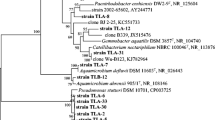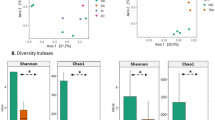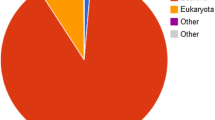Abstract
Despite the fact that several approaches have been applied for the bioremediation of olive mill wastewaters, little information is available on bacteria inhabiting these agro-industrial effluents. In the present study, 16S rRNA gene clone libraries were constructed to identify bacterial diversity in olive-oil mill wastewaters generated by two olive varieties, Olea europaea var. mastoidis and O. europaea var. koroneiki. Due to chloroplast excess in wastewater produced from the processing of O. europaea var. koroneiki, a clone library using specific PCR primers for β-Proteobacteria was further constructed. The bacterial diversity in O. europaea var. mastoidis-generated olive mill wastewaters consisted mainly of members of Acetobacteriaceae, Prevotellaceae and Lactobacillaceae, while the majority of β-proteobacteria identified in O. europaea var. koroneiki-generated olive mill wastewaters were placed within the families Comamonadaceae, Oxalobacteraceae, Hydrogenophilaceae and Rhodocyclaceae. At least 17 novel phylogenetic linkages among Bacteria were identified. Olive-oil mill wastewaters microbiota appears to have originated from soil and freshwater environments, while the cultivation and harvesting practice highly influenced the bacterial community structure in olive mill wastewaters. The presence of fecal bacteria in O. europaea var. mastoidis-generated olive mill wastewaters, due to the long harvesting period, should be of concern.


Similar content being viewed by others
References
Asses N, Ayed L, Bouallagui H, Ben Rejeb I, Gargouri M, Hamdi M (2009) Use of Geotrichum candidum for olive mill wastewater treatment in submerged and static culture. Bioresour Technol 100:2182–2188
Banat IM, Marchant R, Rahman TJ (2004) Geobacillus debilis sp. nov., a novel obligately thermophilic bacterium isolated from a cool soil environment, and reassignment of Bacillus pallidus to Geobacillus pallidus comb. nov. Int J Syst Evol Microbiol 54:2197–2201
Barberio C, Spagnesi S, Marchetti L, Fava F (2002) Characterization of four olive-mill-wastewater indigenous bacterial strains capable of aerobically degrading hydroxylated and methoxylated monocyclic aromatic compounds. Arch Microbiol 178:208–217
Ben Sassi A, Boularbah A, Jaouad A, Walker G, Boussaid A (2006) A comparison of Olive oil Mill Wastewaters (OMW) from three different processes in Morocco. Process Biochem 41:74–78
Bertin L, Colao MC, Ruzzi M, Fava F (2004) Performances and microbial features of a granular activated carbon packed-bed biofilm reactor capable of an efficient anaerobic digestion of olive mill wastewaters. FEMS Microbiol Ecol 48:413–423
Bertin L, Colao MC, Ruzzi M, Marchetti L, Fava F (2006) Performances and microbial features of an aerobic packed-bed biofilm reactor developed to post-treat an olive mill effluent from an anaerobic GAC reactor. Microb Cell Fact 5:art. no. 16
Blackwood CB, Oaks A, Buyer JS (2005) Phylum- and class-specific PCR primers for general microbial community analysis. Appl Environ Microbiol 71:6193–6198
Bryant MP (1986) Genus Ruminococcus. In: Sneath PHA, Mair NS, Sharpe ME, Holt JG (eds) Bergey’s manual of systematic bacteriology, vol 2. Williams & Wilkins, Baltimore, pp 1093–1097
Camu N, De Winter T, Verbrugghe K, Cleenwerck I, Vandamme P, Takrama JS, Vancanneyt M, De Vuyst L (2007) Dynamics and biodiversity of populations of lactic acid bacteria and acetic acid bacteria involved in spontaneous heap fermentation of cocoa beans in Ghana. Appl Environ Microbiol 73:1809–1824
Capasso R, Cristinzio G, Evidente A, Scognamiglio F (1992) Isolation, spectroscopy and selective phytotoxic effects of polyphenols from vegetable waste-waters. Phytochemistry 31:4125–4128
Casa R, D’Annibale A, Pieruccetti F, Stazi SR, Sermanni GG, Lo Cascio B (2003) Reduction of the phenolic components in olive-mill wastewater by an enzymatic treatment and its impact on durum wheat (Triticum durum Desf.) germinability. Chemosphere 50:959–966
Cato EP, George WL, Finegold SM (1986) Genus Clostridium Prazmowski 1880, 23AL. In: Sneath PHA, Mair NS, Sharpe ME, Holt JG (eds) Bergey’s manual of systematic bacteriology, vol 2. Williams & Wilkins, Baltimore, pp 1141–1200
Chamkha M, Mnif S, Sayadi S (2008) Isolation of a thermophilic and halophilic tyrosol-degrading Geobacillus from a Tunisian high-temperature oil field. FEMS Microbiol Lett 283:23–29
Clesceri LS, Greenberg AE, Eaton AD (1998) Standard methods for the examination of water and wastewater. American Public Health Association (APHA), Washington DC
Di Gioia D, Barberio C, Spagnesi S, Marchetti L, Fava F (2002) Characterization of four olive-mill-wastewater indigenous bacterial strains capable of aerobically degrading hydroxylated and methoxylated monocyclic aromatic compounds. Arch Microbiol 178:208–217
Edwards U, Rogall T, Blocker H, Emde M, Bottger EC (1989) Isolation and direct complete nucleotide determination of entire genes. Characterization of a gene coding for 16S ribosomal RNA. Nucleic Acids Res 17:7843–7853
El Asli A, Errachidi F, Bennisse R, Qatibi A-I, Errami M (2005) Effect of cell immobilization on the treatment of olive mill wastewater by a total phenols, acetic acid and formic acid degrading bacterium strain. Grasas Aceites 56:116–120
Fahrbach M, Kuever J, Meinke R, Kämpfer P, Hollender J (2006) Denitratisoma oestradiolicum gen. nov., sp. nov., a 17 β-oestradiol-degrading, denitrifying betaproteobacterium. Int J Syst Evol Microbiol 56:1547–1552
Fink DL, Geme JW (2006) The Genus Haemophilus. In: Dworkin M, Falkow S, Rosenberg E, Schleifer K-H, Stackebrandt E (eds) The prokaryotes, vol 6, 3rd edn. New York, Springer, pp 1034–1061
García García I, Jiménez Peña PR, Bonilla Venceslada JL, Martín Martín A, Martín Santos MA, Ramos Gómez E (2000) Removal of phenol compounds from olive mill wastewater using Phanerochaete chrysosporium, Aspergillus niger, Aspergillus terreus and Geotrichum candidum. Process Biochem 35:751–758
Govorukhina NI, Kletsova LV, Tsygankov YuD, Trotsenko YuA, Netrusov AI (1987) Characteristics of a new obligate methylotroph. Mikrobiologiya 56:849–854
Hafidi M, Amir S, Revel JC (2005) Structural characterization of olive mill waster-water after aerobic digestion using elemental analysis, FTIR and C-13 NMR. Process Biochem 40:2615–2622
Hallbeck L, Stahl F, Pedersen K (1993) Phylogeny and phenotypic characterization of the stalk-forming and iron-oxidizing bacterium Gallionella ferruginea. J Gen Microbiol 139:1531–1535
Hammes WP, Hertel C (2006) The genera Lactobacillus and Carnobacterium. In: Dworkin M, Falkow S, Rosenberg E, Schleifer K-H, Stackebrandt E (eds) The prokaryotes, vol 4, 3rd edn. Springer, New York, pp 320–403
Hayashi NR (1999) Hydrogenophilus thermoluteolus gen. nov., sp. nov., a thermophilic, facultatively chemolithoautotrophic, hydrogen-oxidizing bacterium. Int J Syst Bacteriol 49:783–786
Huber T, Faulkner G, Hugenholtz P (2004) Bellerophon: a program to detect chimeric sequences in multiple sequence alignments. Bioinformatics 20:2317–2319
Hughes SA, Shewry PR, Gibson GR, McCleary BV, Rastall RA (2008) In vitro fermentation of oat and barley derived β-glucans by human faecal microbiota. FEMS Microbiol Ecol 64:482–493
Imhoff JF (2005) Genus Incertae Sedis. XV Rubrivivax, Willems, Gillis and De Ley 1991b, 70VP. In: Brenner DJ, Krieg NR, Staley JT, Garrity GM (eds) Bergey’s Manual of Systematic Bacteriology, vol 2, 2nd edn. Springer, New York, pp 749–750
Jones CE, Murphy PJ, Russell NJ (2000) Diversity and osmoregulatory responses of bacteria isolated from two-phase olive oil extraction waste products. World J Microbiol Biotechnol 16:555–561
Jukes TH, Cantor CR (1969) Evolution of protein molecules. In: Munro HN (ed) Mammalian protein metabolism. Academic Press, New York, pp 21–132
Kersters K, Lisdiyanti P, Komagata K, Swings J (2006) The family Acetobacteraceae: the genera Acetobacter, Acidomonas, Asaia, Gluconacetobacter, Gluconobacter, and Kozakia. In: Dworkin M, Falkow S, Rosenberg E, Schleifer K-H, Stackebrandt E (eds) The prokaryotes, vol 5, 3rd edn. Springer, New York, pp 163–200
Kim J-D, Kang K-H (2004) Analysis of enzymes of Stenotrophomonas maltophilia LK-24 associated with phenol degradation. Korean J Microbiol Biotechnol 32:37–46
Kojima H, Fukui M (2003) Phylogenetic analysis of Beggiatoa spp. from organic rich sediment of Tokyo Bay. Jpn Water Res 37:3216–3223
Koussémon M, Combet-Blanc Y, Patel BKC, Cayol J-L, Thomas P, Garcia J-L, Ollivier B (2001) Propionibacterium microaerophilum sp. nov., a microaerophilic bacterium isolated from olive mill wastewater. Int J Syst Evol Microbiol 51:1373–1382
Lamia A, Moktar H (2003) Fermentative decolorization of olive mill wastewater by Lactobacillus plantarum. Process Biochem 39:59–65
Liebgott P-P, Joseph M, Fardeau M-L, Cayol J-L, Falsen E, Chamkh F, Oatibi A-I, Labat M (2008) Clostridiisalibacter paucivorans gen. nov., sp. nov., a novel moderately halophilic bacterium isolated from olive mill wastewater. Int J Syst Evol Microbiol 58:61–67
Lisdiyanti P, Kawasaki H, Seki T, Yamada Y, Uchimura T, Komagata K (2000) Systematic study of the genus Acetobacter with descriptions of Acetobacter indonesiensis sp. nov., Acetobacter tropicalis sp. nov., Acetobacter orleanensis (Henneberg 1906) comb. nov., Acetobacter lovaniensis (Frateur 1950) comb. nov., Acetobacter estunensis (Carr 1958) comb. nov. J Gen Appl Microbiol 46:147–165
Lisdiyanti P, Kawasaki H, Seki T, Yamada Y, Uchimura T, Komagata K (2001) Identification of Acetobacter strains isolated from Indonesian sources, and proposals of Acetobacter syzygii sp. nov., Acetobacter cibinongensis sp. nov., and Acetobacter orientalis sp. nov. J Gen Appl Microbiol 47:119–131
Magurran AE (1988) Ecological diversity and its measurement. Princeton University Press, Princeton
Morillo JA, Aguilera M, Antízar-Ladislao B, Fuentes S, Ramos-Cormenzana A, Russell NJ, Monteoliva-Sánchez M (2008) Molecular microbial and chemical investigation of the bioremediation of two-phase olive mill waste using laboratory-scale bioreactors. Appl Microbiol Biotechnol 79:309–317
Mulder EG, Dienema MH (1992) The sheathed bacteria. In: Balows A, Truper HG, Dworkin M, Harder W, Schleifer K-H (eds) The prokaryotes, vol 3, 2nd edn. Springer, New York, pp 2612–2624
Nielsen P, Fritze D, Priest EG (1995) Phenetic diversity of alkaliphilic Bacillus strains: proposal for nine new species. Microbiology 141:1745–1761
Ntougias S, Zervakis GI, Ehaliotis C, Kavroulakis N, Papadopoulou KK (2006) Ecophysiology and molecular phylogeny of bacteria isolated from alkaline two-phase olive mill wastes. Res Microbiol 157:376–385
Ntougias S, Papadopoulou KK, Zervakis GI, Kavroulakis N, Ehaliotis C (2008) Suppression of soil-borne pathogens of tomato by composts derived from agro-industrial wastes abundant in Mediterranean regions. Biol Fert Soils 44:1081–1090
Okabe S, Shimazu Y (2007) Persistence of host-specific Bacteroides-Prevotella 16S rRNA genetic markers in environmental waters: Effects of temperature and salinity. Appl Microbiol Biot 76:935–944
Ongol MP, Asano K (2009) Main microorganisms involved in the fermentation of Ugandan ghee. Int J Food Microbiol 133:286–291
Palleroni N, Bradbury J (1993) Stenotrophomonas, a new bacterial genus for Xanthomonas maltophilia (Hugh 1980) Swings et al. 1983. Int J Syst Bacteriol 43:606–609
Panizza M, Cerisola G (2006) Olive mill wastewater treatment by anodic oxidation with parallel plate electrodes. Water Res 40:1179–1184
Pozo C, Rodelas B, Martínez-Toledo MV, Vílchez R, González-López J (2007) Removal of organic load from olive washing water by an aerated submerged biofilter and profiling of the bacterial community involved in the process. J Microbiol Biotechnol 17:784–791
Rincón B, Raposo F, Borja R, Gonzalez JM, Portillo MC, Saiz-Jimenez C (2006) Performance and microbial communities of a continuous stirred tank anaerobic reactor treating two-phases olive mill solid wastes at low organic loading rates. J Biotechnol 121:534–543
Saez L, Perez J, Martinez J (1992) Low-molecular-weight phenolics attenuation during simulated treatment of wastewaters from olive oil mills in evaporation ponds. Water Res 26:1261–1266
Saitou N, Nei M (1987) The neighbor-joining method - a new method for reconstructing phylogenetic trees. Mol Biol Evol 4:406–425
Sambrook J, Russell DW (2001) Molecular cloning: a laboratory manual, 3rd edn. Cold Spring Harbor Laboratory Press, New York
Sleat R, Mah RA (1985) Clostridium populeti sp. nov., a cellulolytic species from a woody-biomass digestor. Int J Syst Bacteriol 35:160–163
Spring S, Jäckel U, Wagner M, Kämpfer P (2004) Ottowia thiooxydans gen. nov., sp. nov., a novel facultatively anaerobic, N2O-producing bacterium isolated from activated sludge, and transfer of Aquaspirillum gracile to Hylemonella gracilis gen. nov., comb. nov. Int J Syst Evol Microbiol 54:99–106
Stackebrandt E, Goebel BM (1994) Taxonomic note: a place for DNA-DNA reassociation and 16S rRNA sequence analysis in the present species definition in bacteriology. Int J Syst Bacteriol 44:846–849
Tarlera S, Denner EBM (2003) Sterolibacterium denitrificans gen. nov., sp. nov., a novel cholesterol-oxidizing, denitrifying member of the β-Proteobacteria. Int J Syst Evol Microbiol 53:1085–1091
Teng JLL, Woo PCY, Leung KW, Lau SKP, Wong MKM, Yuen KY (2003) Pseudobacteraemia in a patient with neutropenic fever caused by a novel paenibacillus species: Paenibacillus hongkongensis sp. nov. Mol Pathol 56:29–35
Van de Peer Y, De Wachter R (1993) TREECON: a software package for the construction and drawing of evolutionary trees. Comput Appl Biosci 9:177–182
Vivas A, Moreno B, Garcia-Rodriguez S, Benitez E (2009) Assessing the impact of composting and vermicomposting on bacterial community size and structure, and microbial functional diversity of an olive-mill waste. Bioresour Technol 100:1319–1326
Wade WG (2006) The genus Eubacterium and related genera. In: Dworkin M, Falkow S, Rosenberg E, Schleifer K-H, Stackebrandt E (eds) The prokaryotes, vol 4, 3rd edn. Springer, New York, pp 818–830
Willems A, De Ley J, Gillis M, Kersters K (1991) Comamonadaceae, a new family encompassing the acidovorans rRNA complex, including Variovorax paradoxus gen. nov., comb. nov., for Alcaligenes paradoxus (Davis 1969). Int J Syst Bacteriol 41:445–450
Yanagida F, Suzuki KI, Kozaki M, Komagata K (1997) Proposal of Sporolactobacillus nakayamae subsp. nakayamae sp. nov., subsp. nov., Sporolactobacillus nakayamae subsp. racemicus subsp. nov., Sporolactobacillus terrae sp. nov., Sporolactobacillus kofuensis sp. nov., and Sporolactobacillus lactosus sp. nov. Int J Syst Bacteriol 47:499–504
Zucconi F, Pera A, Forte M, de Bertoldi M (1981) Evaluating toxicity of immature compost. BioCycle 22:54–57
Author information
Authors and Affiliations
Corresponding author
Electronic supplementary material
Below is the link to the electronic supplementary material.
Rights and permissions
About this article
Cite this article
Kavroulakis, N., Ntougias, S. Bacterial and β-proteobacterial diversity in Olea europaea var. mastoidis- and O. europaea var. koroneiki-generated olive mill wastewaters: influence of cultivation and harvesting practice on bacterial community structure. World J Microbiol Biotechnol 27, 57–66 (2011). https://doi.org/10.1007/s11274-010-0426-3
Received:
Accepted:
Published:
Issue Date:
DOI: https://doi.org/10.1007/s11274-010-0426-3




